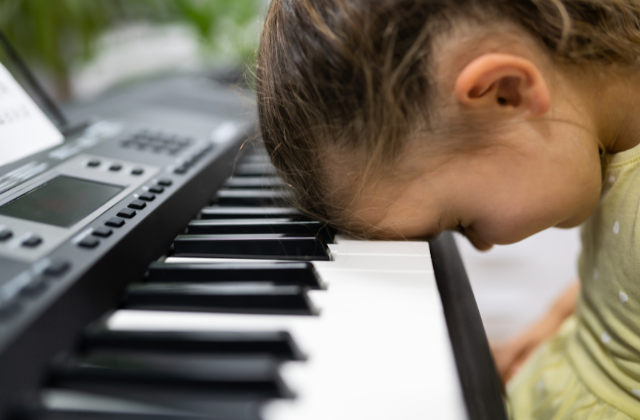
This article about encouraging a growth mindset instead of piano student perfectionism was written by Gemma Wilkins. Gemma runs a music teaching studio in the regional town of Mudgee in Australia. She completed her degree in Music Performance while on maternity leave in 2018 and returned to teaching again after the birth of her son in April 2020. Teaching piano to preschoolers and primary-aged students while raising two young children has been her reality and her joy ever since, which she talks about more on her website
The perfectionism beast in piano students can be a bear to grapple with as a music teacher. The drive for flawless playing is often detrimental to a student’s progress, and hinders their love and appreciation for music.

If you’ve been teaching for any length of time, you’ve probably come across students who believe that only error-free playing will do. This likely had (or still has!) a negative impact on their musical growth.
Rather than a healthy, hard-working strive to achieve mastery, these students are stymied by feeling not “good enough” simply because they aren’t playing without making a few mistakes.
But there’s a difference between healthy striving and perfectionism.
Since that’s the case, how does a teacher help students distinguish between the two?
Pinpoint Perfectionism
I define perfectionism as a student’s need or desire to be impeccable in their playing, regardless of how long they’ve been working on a piece or how new a concept is to them.
Students who are prone to perfectionism may be more difficult to teach. They often close off at recommendations for improvement, or are reluctant to show you something they’ve been working on.
Common Indicators of Perfectionism
Perfectionism has various manifestations, but it’s usually noticeable when students (1) refuse to have a go for fear of being wrong, (2) are outwardly self-critical or (3) have difficulty polishing a piece.
In addition to these behaviours, I find that student perfectionism frequently looks like:
- Reluctance to start a new piece in lessons, preferring to practise at home in private first
- Frequently abandoning pieces before final polish
- High sensitivity to feedback
- Constantly seeking confirmation that what they played was correct
Students who act in these ways are often triggered by an underlying fear of failure or the pressure of high expectations from parents or teachers.
(Note: Even though these are typical reasons for student perfectionism, you may never know a student’s real reason for this tendency.)
As their teacher, it’s important to recognise when a student is struggling with perfectionism and do what you can to shift that towards a healthier mindset, keeping their enjoyment in piano lessons ticking along.
One of these things is not like the other…
The main difference between perfectionism and a determination to reach one’s full potential is a growth mindset. The student with this mentality has realistic expectations of themselves, but is still interested in getting things right.
Students who are working hard to reach the highest standards will show joy in playing piano, and will display satisfaction when they reach proficiency in their music.
Those who are pushing to play flawlessly may never feel pleased by their achievement, and tend to lose enjoyment in lessons.

When practising at home, the perfectionist:
- Stalls progress because they can’t overcome difficulties
- Ignores the teacher’s practice recommendations
- Thinks something should be easier for them than it actually is
The heathfully striving student, however:
- Accepts mistakes and continues practising until the next lesson
- Takes recommendations and applies them in home practice sessions
- Has realistic expectations on how long it will take to overcome the hard things
Now that you understand the mindsets, what can you do in lessons to help students beat perfectionism and replace it with vigorous ambition?
4 Ways to Embrace “Healthy Striving”
With these four tactics, you can help your piano students learn that perseverance and perfectionism are not the same thing.
No. 1: Shift Mindsets
While at university one of my tutors would say, “Perfection is static, but excellence is dynamic.” (How about we make that a mantra we pass on to our students?🧘)
Aiming for a single, end goal of perfection is a road to nowhere.
Aspiring for mastery, however, leads down a winding path filled with mistakes, fumbles and missteps. But that’s where growth, development and improvement are eventually found.
No. 2: Reframe Perfectionism
Help your students reimagine perfectionism as a desire for excellence rather than the aim to be mistake-free.
Set realistic goals together and accept errors as a natural part of the learning process.
- Practise mindfulness and self-compassion to reduce self-criticism.
- Make mistakes in front of a student, and brush it off quickly. Laugh at yourself and demonstrate “to err is human”.
- Celebrate even the smallest successes, focussing on progress and work rather than outcomes.
- Add a “yet” to their “I can’t!” statements. Reinforce this habit with the game ‘Yeti Yetters’, available instantly for Vibrant Music Teaching members.
Not a VMT member yet? Find out what you’ve been missing and join today at vibrantmusicteaching.com.
No. 3: Reimagine Lesson Activities
For those students who want their playing to be flawless, it can be helpful to change up your lessons a little bit.
Challenge the “I-must-play-everything-without-making-mistakes” attitude with games and activities that give space and grace for blunders.
- Improvise (solo or duet, with or without backing tracks)
- Use lead sheets and/or pop songs
- Play ‘Unicorn Horncraft‘, which forces students to deliberately play the wrong note (and gets them laughing to boot!)
- Try strategies that encourage playing far too quickly or too slowly, such as ‘Koala Kangaroo Caribou’ from the VMT Library’s ‘Practice Plays‘
- Assign rote pieces or play “Follow the Leader”
- Include composition projects
Enter your info below and Nicola will have the ‘Unicorn Horncraft’ game flying to your inbox in a wink!

Subscribe to the newsletter and get unicorn horncraft
Enter your details to subscribe to the newsletter for piano teachers with information, tips and offers.
I hate spam as much as you do! I will only send you emails related directly to piano teaching and you can unsubscribe at any time.
Members of VMT can visit the exclusive Printable Library to download ‘Unicorn Horncraft‘ and other games that promote a growth mindset. Not a VMT member yet? Join today at vibrantmusicteaching.com.
No. 4: Build in Easy Wins
When assigning pieces, shift between challenging pieces and ones that are the same level – or even easier – than the previous one. By including repertoire that is relatively simple to master, the student gains confidence in their ability as well as greater joy in their playing.
Improvisation is another fantastic strategy for giving students quick victories. (There are no mistakes when it comes to improv, am I right?!)
Encourage students to improvise at home, too, and free them from worrying about mistakes. For an even greater feel of security, give them access to backing tracks to use at home, like these tracks available exclusively for Vibrant Music Teaching members.
Not a VMT member yet? Find out what you’ve been missing and join today at vibrantmusicteaching.com.
Whilst these ideas can help, always strive to put the focus on encouraging students to be kind to themselves and remind them that perfectionism is not necessary to be a good pianist – in fact, it tends to be counterproductive.

What do you do to help your students defeat perfectionism?
Let me know in the comments below.
Colourful Keys has an entire section of their website devoted to teaching students how to practice. Check it out today for more articles like this one.